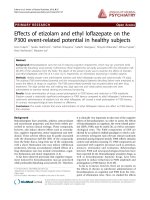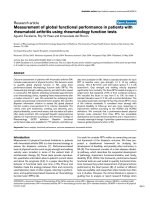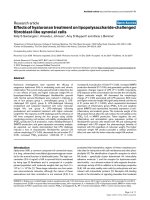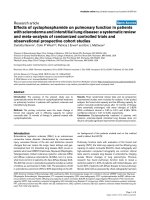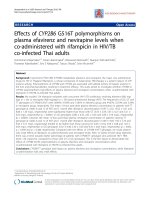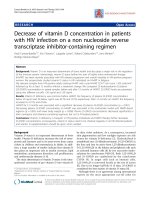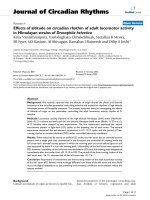Báo cáo y học: "Effects of unilateral decompressive craniectomy on patients with unilateral acute post-traumatic brain swelling after severe traumatic brain injury" pps
Bạn đang xem bản rút gọn của tài liệu. Xem và tải ngay bản đầy đủ của tài liệu tại đây (140.06 KB, 7 trang )
Open Access
Available online />Page 1 of 7
(page number not for citation purposes)
Vol 13 No 6
Research
Effects of unilateral decompressive craniectomy on patients with
unilateral acute post-traumatic brain swelling after severe
traumatic brain injury
Wusi Qiu
1,2,3
*, Chenchen Guo
1,2
, Hong Shen
2,3
*, Keyong Chen
1
, Liang Wen
2
, Hongjie Huang
1
,
Min Ding
1
, Li Sun
1
, Qizhou Jiang
1
and Weiming Wang
1
1
Department of Neurosurgery, Hangzhou Second Hospital, College of Medicine, Hangzhou Normal University, 126 Wenzhou Road, Hangzhou,
310015, China
2
Brain Medicine Research Institute, College of Medicine, Zhejiang University, 88 Jiefang Road, Hangzhou, 310009, China
3
Department of Neurosurgery, Second Affiliated Hospital, College of Medicine, Zhejiang University, 88 Jiefang Road, Hangzhou, 310009, China
* Contributed equally
Corresponding author: Hong Shen,
Received: 6 Apr 2009 Revisions requested: 3 Jun 2009 Revisions received: 21 Aug 2009 Accepted: 23 Nov 2009 Published: 23 Nov 2009
Critical Care 2009, 13:R185 (doi:10.1186/cc8178)
This article is online at: />© 2009 Qiu et al; licensee BioMed Central Ltd.
This is an Open Access article distributed under the terms of the Creative Commons Attribution License ( />2.0), which permits unrestricted use, distribution, and reproduction in any medium, provided the original work is properly cited.
Abstract
Introduction Acute post-traumatic brain swelling (BS) is one of
the pathological forms that need emergent treatment following
traumatic brain injury. There is controversy about the effects of
craniotomy on acute post-traumatic BS. The aim of the present
clinical study was to assess the efficacy of unilateral
decompressive craniectomy (DC) or unilateral routine
temporoparietal craniectomy on patients with unilateral acute
post-traumatic BS.
Methods Seventy-four patients of unilateral acute post-
traumatic BS with midline shifting more than 5 mm were divided
randomly into two groups: unilateral DC group (n = 37) and
unilateral routine temporoparietal craniectomy group (control
group, n = 37). The vital signs, the intracranial pressure (ICP),
the Glasgow outcome scale (GOS), the mortality rate and the
complications were prospectively analysed.
Results The mean ICP values of patients in the unilateral DC
group at hour 24, hour 48, hour 72 and hour 96 after injury were
much lower than those of the control group (15.19 +/- 2.18
mmHg, 16.53 +/- 1.53 mmHg, 15.98 +/- 2.24 mmHg and
13.518 +/- 2.33 mmHg versus 19.95 +/- 2.24 mmHg, 18.32 +/
- 1.77 mmHg, 21.05 +/- 2.23 mmHg and 17.68 +/- 1.40 mmHg,
respectively). The mortality rates at 1 month after treatment were
27% in the unilateral DC group and 57% in the control group (p
= 0.010). Good neurological outcome (GOS Score of 4 to 5)
rates 1 year after injury for the groups were 56.8% and 32.4%,
respectively (p = 0.035). The incidences of delayed intracranial
hematoma and subdural effusion were 21.6% and 10.8%
versus 5.4% and 0, respectively (p = 0.041 and 0.040).
Conclusions Our data suggest that unilateral DC has
superiority in lowering ICP, reducing the mortality rate and
improving neurological outcomes over unilateral routine
temporoparietal craniectomy. However, it increases the
incidence of delayed intracranial hematomas and subdural
effusion, some of which need secondary surgical intervention.
These results provide information important for further large and
multicenter clinical trials on the effects of DC in patients with
acute post-traumatic BS.
Trial registration ISRCTN14110527
Introduction
Acute post-traumatic brain swelling (BS), one variety of the
pathological forms of diffuse brain injury, has been described
as the increase of brain size in the several hours following trau-
matic brain injury (TBI) without obvious intracranial hematoma
[1-7]. The pathophysiological entity of post-traumatic BS is
not yet fully understood [5,7]. It has been indicated that cyto-
toxic edema, rather than vasogenic edema or cerebral vaso-
congestion, could contribute to this phenomenon. Acute post-
traumatic BS can be classified into hemisphere BS and diffuse
BS: brain swelling; CSF: cerebrospinal fluid; CT: computed tomography; DC: decompressive craniectomy; GCS: Glasgow Coma Scale; GOS: Glas-
gow Outcome Scale; ICP: intracranial pressure; TBI: traumatic brain injury.
Critical Care Vol 13 No 6 Qiu et al.
Page 2 of 7
(page number not for citation purposes)
BS based on computed tomography (CT) scans [2,5,7-9].
Without appropriate management, the subsequent increase of
intracranial pressure (ICP) with extensive swelling and disten-
sion of cerebral tissues would lead to the deterioration of
patients with TBI in the critical care department [1-4]. If the ini-
tial medical management, such as sedation, drainage of cere-
brospinal fluid (CSF), and osmotherapy, is refractory to the
intracranial hypertension, the second tier of management such
as therapeutic hypothermia management or decompressive
craniectomy (DC) should be considered [2,5,6].
Despite maximal medical management, such as dehydration
and pentobarbital coma, there is still a high risk of morbidity
and death in patients with traumatic BS [1-3,5,7]. It has also
been indicated that surgical decompression should be rou-
tinely performed before irreversible brain damage occurs for
some subgroups of patients with post-traumatic BS. The
rationale for decompression is to reduce ICP, to prevent her-
niation and the vicious circle of further BS, and to combat the
deleterious effects of TBI. Previous studies, including ours,
have demonstrated that acute post-traumatic BS should be
diagnosed correctly and promptly with CT scanning as soon
as possible, and for patients with midline shift of more than 5
mm, especially with thin-layered subdural hematoma, surgical
intervention is essential to reduce the fatality of acute post-
traumatic BS [5,7-10].
Although the importance of DC in the treatment of traumatic
BS has been demonstrated in several studies, there are rare
results from randomized trials to confirm or refute the effective-
ness of DC in adults, and the criterion and the safety of this
treatment has not been fully recognized [5,7-10]. DC for some
subgroups of patients with acute post-traumatic BS may be
useful, because this kind of treatment may be a useful option
when maximal medical treatment has failed to control refrac-
tory high ICP in TBI resulting from the acute post-traumatic BS
[4,9,11,12].
To further investigate the therapeutic effects and the compli-
cations of unilateral DC on post-traumatic BS, we conducted
a clinical trial, and the effects as well as the main complica-
tions were analyzed.
Materials and methods
Study design
This clinical study was designed as a prospective randomized
clinical trial. The research protocol was approved by the Insti-
tutional Review Board and the ethical committees of Clinical
Medical College of Hangzhou, according to Good Clinical
Practice standards, and Declaration of Helsinki principles
were strictly followed. As the patients in this study were inca-
pable of granting informed consent, investigators therefore
obtained informed consent from the subject's legal guardian or
healthy proxy before accepting the advised treatment.
After informed consent was obtained from the patient's family,
the patient was assigned to one of the following two groups
using a randomization table. Allocation and randomization was
concealed and the investigators were not aware to which
group the patient would be assigned, and the allocation
sequence was protected until assignment. The physicians in
charge of the patient were not involved in data collection, and
the nursing staff and the surgical team were not aware of the
patient's group assignment. A single trained assessor and the
data analyzer were blind to the treatment group. Therefore,
biased grouping was avoided, and adherence to the principles
of control, random, equilibrium was ensured.
Patient population and grouping
Of 7291 adult in-patients with severe TBI admitted to our
department between 2000 and 2008, 74 patients with acute
post-traumatic BS with midline shifting more than 5 mm were
enrolled in our clinical trial. There were 51 male and 23 female
patients with severe TBI, with age ranging from 18 to 65 (40.1
± 11.8) years. All the patients met the following criteria: a his-
tory of TBI, Glasgow Coma Scale (GCS) of 8 or less at admis-
sion, and swollen hemisphere (43 left and 31 right, with
midline shift >5 mm and contusions <25 ml and compressed
basal cisterns) apparent on CT scans. There were 10 cases of
traumatic cerebral hemisphere infarction, 13 cases with a thin
layer of subdural hematoma (less than 2 mm, and not consist-
ent with the midline shift), 19 cases with midline shift more
than 10 mm, and 51 cases with compressed or obliterated
basilar cistern and/or cisterna ambiens. Sequential CT con-
firmed the diagnosis within 1 to 19 hours (mean 5.1 hours).
Patients below the age of 18 years or above 65 years, multiply-
injured patients, those with any previous disabling neurologi-
cal disease, intracerebral haematoma of more than 3 cm in
diameter, previous craniectomy, extra-axial haematoma greater
than 0.5 cm in thickness, spinal cord injury, penetrating brain
injury, fixed dilated pupils and GCS score of 3 with no chance
of survival, were excluded.
Craniotomy was undergone for all patients from 2 to 24 hours
(mean 5.8 hours) after admission, and randomized into two
groups as follows: unilateral DC group (n = 37) and unilateral
routine temporoparietal craniectomy group as control group (n
= 37). The main characteristics of the patients are shown in
Table 1.
Management procedures
Based on the guidelines for the management of severe head
injury set forth by the Joint Section on Neurotrauma and Criti-
cal Care of the Brain Trauma Foundation and the American
Association of Neurological Surgeons, all patients underwent
lateral craniotomy within 24 hours after injury and other medi-
cal management such as dehydration with mannitol (average
amount received in subsequent six-hour period was 125 ml
20% mannitol) and routine pharmacological or physical meas-
Available online />Page 3 of 7
(page number not for citation purposes)
ures adopted to maintain normal body temperature after diag-
nosis of post-traumatic BS accordingly.
The surgery mode of DC was elective at the frontoparietotem-
poral region, based on the lesion location and midline shift
determined by CT scans [7]. Briefly, the bone window was
about 15 cm in diameter with duraplasty using expanded dura
substitute when necessary. The anterior was frontal to the mid-
pupillary lines, and the posterior line was about 3 to 4 cm pos-
terior to the external acustic meatus. The superior line was 2
cm of the lateral edge of the superior sagittal sinus, and the
inferior line was extended below the level of the zygomatic
arch, so that the frontal and temporal base could be explored.
Durotomy was performed over the entire region of bony
decompression as a stellate shape. Cranioplasty was per-
formed after three months.
Postoperative therapy was similar to that previously described,
which included elevation of the upper part of the body by 15
to 30 degrees, keeping the respiratory tract unobstructed
(with assisted ventilation to ensure oxygen saturation of 95%
or more against hypoxia and partial pressure of arterial carbon
dioxide maintained at about 40 mmHg at 37°C), maintaining
intubation, sedation and continuous muscle relaxation if nec-
essary, controlling the blood glucose level and body tempera-
ture and balancing water and electrolyte levels, preventing
dehydration and diuresis, maintaining homeostasis balance
and anti-infection with sensitive antibiotics, ensuring normoth-
ermia and so on [5,7-10].
The control group received the unilateral routine temporopari-
etal craniectomy and the operation site depended on the loca-
tion of injury and midline shift accordingly [7]. The bone
window diameter was about 8 cm and the dura mater was also
fixed at the edge with duraplasty, and cranioplasty was also
performed after three months. In the routine craniotomy group,
postoperative treatment was similar to those in the unilateral
DC group.
Monitoring parameters
The following parameters of the patients were monitored at
admission and after craniotomy. (1) The temperature, heart
rate, respiration rate and blood pressure, arterial oxygen satu-
ration with the multiple monitor (Model NO: 90309, Space
Lab, Medical. Inc., Issaquah, Washington, USA). The data
were recorded at every 12 hours for 7 days after craniotomy.
(2) Continuous recording of ICP was applied in all patients for
96 hours with the ICP monitor system (Camino-MPM1, Integra
LifeSciences CO, Plainsboro, New Jersey, USA.). A cranial
hole was drilled, if necessary, and the drainage catheter was
induced 5 cm or so into the right lateral ventricles via the level
of the anterior horn. The intraventricular pressure probe
(Camino-110-4B Integra LifeSciences CO, Plainsboro, New
Jersey, USA) was placed at the level of foramen of Monro dur-
Table 1
Main clinical and demographic characteristics between the two groups
Variable Unilatereal DC group
(n = 37)
Control group
(n = 37)
P-values
Number of male patients (%) 27 (73.0) 24 (64.9) 0.616
Mean age (years) 39.9 ± 1.9 40.2 ± 11.9 0.895
GCS score
3-5 (%) 9 (24.3) 10 (27.0) 0.79
6-8 (%) 28 (75.7) 27 (73.0) 0.79
Mechanism of injury
Motor vehicle (%) 30 (81.1) 29 (78.4) 0.772
Fall (%) 5 (13.5) 7 (18.9) 0.528
Other (%) 2 (5.4) 1 (2.7) 0.556
Marshall CT scan classification
I (%) 0 0
II (%) 0 0
III (%) 5 (16.2) 3 (8.1) 0.454
IV (%) 16 (43.2) 17 (45.9) 0.815
V (%) 14 (37.8) 14 (37.8) 1
VI (%) 2 (5.4) 3 (8.1) 0.643
CT = computed tomography; DC = decompressive craniectomy; GCS = Glasgow Coma Scale.
Critical Care Vol 13 No 6 Qiu et al.
Page 4 of 7
(page number not for citation purposes)
ing craniotomy. (3) Complications. Mainly inclusive of delayed
intracranial hematoma, pulmonary infection, digestive tract
hemorrhage, and electrolytes disorders (beyond the normal
serum concentrations of Na
+
, Cl
-
, Mg
2+
, K
+
, P
3+
and Ca
2+
).
The data were recorded every 12 hours for 7 days, and every
24 hours for another 7 days after craniotomy. (4) Glasgow
Outcome Scale (GOS) scores, from 1 to 5 respectively,
according to: death, vegetative state, severe disability, moder-
ate disability, mild or no disability, evaluated at one year follow-
up after injury.
Statistical analysis
The ICP levels are presented as mean ± standard deviation,
and were analyzed with one-way analysis of variance. Neuro-
logical outcomes were evaluated by Cochran-Mantel-Haen-
szel test and by chi-squared tests. Data were measured blind
to treatment group, and were analyzed using SAS statistical
software (version 8; SAS Institute, Cary, NC, USA). A proba-
bility value less than 0.05 was defined as significant differ-
ence.
Results
The vital signs
The temperature, heart rate, respiration rate and blood pres-
sure were kept at normal levels with above-mentioned appro-
priate treatment at every 12 hours for 7 days after craniotomy.
There was no significant difference of abnormality of vital signs
between the two groups.
ICP values
The mean ICP values of patients in the unilateral DC group at
24, 48, 72 and 96 hours after injury were significantly lower
(about 30%) than those of the routine temporoparietal
craniectomy group (15.19 ± 2.18 mmHg, 16.53 ± 1.53
mmHg, 15.98 ± 2.24 mmHg and 13.518 ± 2.33 mmHg ver-
sus 19.95 ± 2.24 mmHg, 18.32 ± 1.77 mmHg, 21.05 ± 2.23
mmHg and 17.68 ± 1.40 mmHg, respectively). Accordingly,
the highest ICP was observed 72 or 48 hours after injury in the
groups, which is consistent with the previous studies.
Neurological outcomes
The mortality rates one month after craniotomy were 27% in
the unilateral DC group as compared with 57% in control
group (P = 0.010). According to the GOS scores one year
after injury, significant difference in overall neurological out-
comes between both groups was found. The difference of
good neurological recovery (GOS score 4 to 5) between the
unilateral DC group and control group was significant (56.8%
versus 32.4%, Table 2).
Complications
There was no evidence of severe complications related to DC.
There were two cases of cenencephalocele (5.4%) in the uni-
lateral DC group. With the bulged brain tissue removed, one
case died in one week and the other remained in a vegetative
state. Delayed intracranial hematoma was seen in eight cases
and contralateral subdural effusion in two cases. Evacuation of
hematoma with secondary craniotomy was undergone for four
cases, and conservative treatment and subdural effusion-peri-
toneal-shunt for every two cases. Therefore, there were four
cases of subdural effusion (10.8%) for patients in the DC
group. There were six cases of cenencephalocele (16.2%) in
the control group. With bone window enlarged and the cenen-
cephalocele brain tissue removed, four cases died of central
respiratory failure within three days, and the remaining two
cases died within 10 days.
There were two cases of subdural hematoma (5.4%) in the
control group, and they were cured with conservative treat-
ment. There was one case of intracranial infection confirmed
by CSF germiculture, but it was cured with recurrent lumbar
puncture, CSF drainage and other anti-infection measures.
The incidence rate of pulmonary infection, hemorrhage in
digestive tract, hypoglycemia (blood sugar <2.6 mmol/L),
blood cell counts, electrolyte disorders or renal malfunction in
two groups was not significant (Table 3).
As shown above, the incidences of delayed intracranial
hematoma and subdural effusion were higher in the unilateral
DC than in the control group (21.6% and 10.8% versus 5.4%
and 0, respectively, P = 0.041 and 0.040). All the complica-
tions were treated and improved without severe sequelae.
There were no severe abnormalities of heart rate, respiration
rate, and blood pressure and arterial blood gas analysis with
above-mentioned appropriate treatment.
Discussion
Although BS could be alleviated by mannitol infusion even
without craniotomy, a subset of patients with malignant BS
after TBI could not be easily manageable, and diffuse unilateral
or bilateral BS has definitive correlation with clinical deteriora-
tion with brain herniation [5,13-17]. The use of DC for severe
TBI was rekindled with the demonstration that DC improved
the outcome in the studies of ischemic and traumatic injury.
Our study also confirmed that unilateral DC had positive
effects on acute post-traumatic BS with a midline shift of more
Table 2
Clinical outcome of two groups at six months follow-up (n, (%))
GOS scores Unilatereal DC group
(n = 37)
Control group
(n = 37)
5 15 (41) 5 (14)
4 6 (16) 7 (19)
3 5 (14) 4 (11)
21 (3) 0
1 10 (27) 21 (57)
DC = decompressive craniectomy; GOS = Glasgow Outcome
Scale.
Available online />Page 5 of 7
(page number not for citation purposes)
than 5 mm. Furthermore, DC seems also to be a successful
option in the treatment of diffuse brain edema after subarach-
noid haemorrhage or space occupying infarction due to vasos-
pasm after subarachnoid haemorrhage.
It is very difficult to decide what kind of operation can not only
reduce ICP but also protect the cerebral tissue from second-
ary brain injury resulting from hypoperfusion and/or hypopres-
sure [9,10,18]. Although DC has been rekindled in different
studies, this procedure is neither first-line treatment nor stand-
ard of care in severe TBI. The time of the DC is one important
factor, especially for post-traumatic BS with subdural
hematoma. Our study demonstrated that acute post-traumatic
BS could coexist with subdural hematoma, and unilateral DC
has superiority in lowering ICP, reducing the mortality rate and
improving neurological outcomes over routine temporoparietal
craniectomy. This is consistent with previous studies
[5,8,12,13,16].
DC can reduce the incidence of cenencephalocele, although
an increase is seen in the incidence of some complications
such as intracerebral hematoma, hygromas and hydrocepha-
lus. However, it seemed that the complication rate after DC
was low and has no serious influence on the patient's progno-
sis [5,10,16]. In the present study, the early complications
including upper gastrointestinal hemorrhage and hypoglyc-
emia are not specific to DC and can be treated and improve
without severe sequelae, but the late complication such as
subdural effusion is a critical one. Our results strongly suggest
that even with the favorable neurological outcome, unilateral
DC increases the incidence of delayed intracranial hemato-
mas and subdural effusion, some of which need further surgi-
cal intervention. It could largely be seen as a last resort
therapeutic option. Routine DC should not be recommended
for all patients with post-traumatic BS [1,5,7,9,13,15].
Although DC is being increasingly investigated for brain injury
irrespective of the underlying disease, the effects of this pro-
cedure on clinical outcome are still controversial [1,2,5,7,18-
23]. We agree on the idea that the application of DC in severe
TBI lacks enough class I evidence relevant to this topic, and
this study aims to conduct the prospective trials on acute post-
traumatic BS. To our knowledge, the following factors are crit-
ical in surgical management of post-traumatic BS: (1) The
trauma type, as well as the criteria in deciding the type of BS
after TBI is important [2,5,13]. Decompression is not impera-
tive for all patients with traumatic BS. For BS without obvious
midline shift, it might progressively resolve and the clinical
state could improve with appropriate treatment such as dehy-
dration. (2) The time, type and techniques of DC should also
be taken into account in perioperative treatment
[2,5,10,13,15,19]. If DC can be accomplished before the ICP
value exceeds 40 mmHg for a sustained period and within 48
hours of the time of injury, the potential to influence outcome
is greatest. As thin-layed subdural hematoma may be associ-
ated with severe neurological prognosis, and elevated ICP is
one of the major deteriorating factors in patients with TBI, the
prevention of intracranial hypertension by decompression
plays a key role with respect to secondary brain injury. There-
fore, if conventional therapy fails in patients suffering from
decompensated intracranial hypertension, the existence of
thin-layed subdural hematoma with BS after TBI may need
decompression as soon as possible, or within 48 hours. In our
study, patients underwent DC within 24 hours, and all patient
outcomes were favorable. The decision to use bilateral or uni-
lateral surgery must be based on the neurological and radio-
logical findings of each patient [5,7,15,19]. (3) Prophylactic
measurement of the possible complications after DC. Besides
the duraplasty and other treatment for prevention of CSF leak-
age, the technique and therapeutic measures against side
effects after DC are essential. Some would develop contralat-
Table 3
Main complications of patients with unilateral brain swelling after severe traumatic brain injury
Variable Unilatereal DC group
(n = 37)
Control group
(n = 37)
P-values
Cenencephalocele (%) 2 (5.4%) 6 (16.2%) 0.134
Delayed intracranial hematoma (%) 8 (21.6%) 2 (5.4%) 0.041
Subdural effusion (%) 4 (10.8%) 0 0.040
Intracranial infection (%) 1 (2.7) 0 0.314
Pulmonary infection (%) 11 (29.7) 13 (35.1) 0.619
Hemorrhage in digestive tract (%) 17 (45.9) 20 (54.0) 0.485
Hypoglycemia (%) 12 (32.4) 13 (35.1) 0.806
Thrombocytopenia (%) 8 (21.6) 7 (18.9) 0.772
Electrolyte disorders (%) 19 (51.4) 23 (62.2) 0.348
Renal malfunction (%) 13 (35.3) 9 (24.3) 0.309
DC = decompressive craniectomy
Critical Care Vol 13 No 6 Qiu et al.
Page 6 of 7
(page number not for citation purposes)
eral or bilateral subdural hematoma and/or subdural effusion,
which may be attributable to DC [9,10,20,21].
The studies reporting complications of DC are rare, some of
which are subdural effusion [12,15,21-28]. When the occupy-
ing effects of subdural hematoma/effusion are present, effec-
tive treatment should be applied. Although the definitive
management is burr-hole drainage of the fluid collection, no
consensus exists on which patients may benefit from surgical
intervention [2,5,12,18,23]. Other treatment interventions
such as hyperventilation, or the use of mannitol, steroids, or
phenobarbitol have been proposed as adjuncts to manage-
ment of patients with TBI. However, internal drainage is the
last resort for the symptomatic subdural effusion (especially
with the mass effect) after DC described here. The supportive
treatment such as effective monitoring of ICP, anti-infection
and basic nursing inclusive of exercising limbs in order to pre-
vent phlebothrombosis is imperative. As early craniotomy put
another impact on the patient, the mean arterial pressure
should be kept within normal limits and hypoxia should be
avoided [24-30].
Conclusions
Although the application of DC in severe TBI is controversial
and the population in the present study is small, our study
demonstrated that unilateral DC had superiority in lowering
ICP, reducing the mortality rate and improving neurological
outcomes over routine temporoparietal craniectomy
[10,25,26]. Furthermore, the indication for DC should be indi-
vidualized. However, our study has demonstrated that unilat-
eral DC increased the incidence of delayed intracranial
hematomas and subdural effusion, some of which need further
surgical intervention. The present results strongly support fur-
ther large, multicenter clinical trials to evaluate the difference
of the effects between DC and other means of craniotomy with
proper evaluation, or of the effects of a combination with other
methods such as hypothermia, of the therapies in acute post-
traumatic BS after severe TBI [10,24-26,31-34].
Competing interests
The authors declare that they have no competing interests.
Authors' contributions
WQ and HS participated in the trial design and were involved
in the study analysis and summary. WQ, CG, QJ and WW
obtained the data. LW, KC, HH, MD and LS participated in the
data analysis and interpretation of the results. All authors
reviewed the final version.
Acknowledgements
The present study was supported by the Scientific Research Fund of
Zhejiang Health Department, the Scientific Research Fund of Hangzhou
Health Department and the Scientific Research Fund of Science and
Technology Department of Zhejiang, China. The authors gratefully
acknowledge the Brain Medicine Research Institute, College of Medi-
cine, Zhejiang University.
References
1. Akins PT, Guppy KH: Sinking skin flaps, paradoxical herniation,
and external brain tamponade: a review of decompressive
craniectomy management. Neurocrit Care 2008, 9:269-276.
2. Chibbaro S, Tacconi L: Role of decompressive craniectomy in
the management of severe head injury with refractory cerebral
edema and intractable intracranial pressure. Our experience
with 48 cases. Surg Neurol 2007, 68:632-638.
3. Cooper DJ, Rosenfeld JV, Murray L, Wolfe R, Ponsford J, Davies A,
D'Urso P, Pellegrino V, Malham G, Kossmann T: Early decom-
pressive craniectomy for patients with severe traumatic brain
injury and refractory intracranial hypertension a pilot rand-
omized trial. J Crit Care 2008, 23:387-393.
4. Schirmer CM, Ackil AA Jr, Malek AM: Decompressive craniec-
tomy. Neurocrit Care 2008, 8:456-470.
5. Guerra WK, Gaab MR, Dietz H, Mueller JU, Piek J, Fritsch MJ: Sur-
gical decompression for traumatic brain swelling: indications
and results. J Neurosurg 1999, 90:187-196.
6. Citerio G, Andrews PJ: Refractory elevated intracranial pres-
sure: intensivist's role in solving the dilemma of decompres-
sive craniectomy. Intensive Care Med 2007, 33:45-48.
7. Liu WG, Qiu WS, Shen H, Wang WM: Management of posttrau-
matic brain swelling based on clinical typing. Chin J Traumatol
2004, 7:175-178.
8. Ucar T, Akyuz M, Kazan S, Tuncer R: Role of decompressive sur-
gery in the management of severe head injuries: prognostic
factors and patient selection. J Neurotrauma 2005,
22:1311-1318.
9. Kofke WA, Stiefel M: Monitoring and intraoperative manage-
ment of elevated intracranial pressure and decompressive
craniectomy. Anesthesiol Clin 2007, 25:579-603. x
10. Qiu W, Zhang Y, Sheng H, Zhang J, Wang W, Liu W, Chen K,
Zhou J, Xu Z: Effects of therapeutic mild hypothermia on
patients with severe traumatic brain injury after craniotomy. J
Crit Care 2007,
22:229-235.
11. Figaji AA, Fieggen AG, Sandler SJ, Argent AC, Le Roux PD, Peter
JC: Intracranial pressure and cerebral oxygenation changes
after decompressive craniectomy in a child with traumatic
brain swelling. Childs Nerv Syst 2007, 23:1331-1335.
12. Howard JL, Cipolle MD, Anderson M, Sabella V, Shollenberger D,
Li PM, Pasquale MD: Outcome after decompressive craniec-
tomy for the treatment of severe traumatic brain injury. J
Trauma 2008, 65:380-385.
13. Skoglund TS, Eriksson-Ritzen C, Jensen C, Rydenhag B: Aspects
on decompressive craniectomy in patients with traumatic
head injuries. J Neurotrauma 2006, 23:1502-1509.
14. Fiorot JA Jr, Silva GS, Cavalheiro S, Massaro AR: Use of decom-
pressive craniectomy in the treatment of hemispheric infarc-
tion. Arq Neuropsiquiatr 2008, 66:204-208.
15. Pompucci A, De Bonis P, Pettorini B, Petrella G, Di Chirico A, Anile
C: Decompressive craniectomy for traumatic brain injury:
patient age and outcome. J Neurotrauma 2007, 24:1182-1188.
16. Timofeev I, Czosnyka M, Nortje J, Smielewski P, Kirkpatrick P,
Gupta A, Hutchinson P: Effect of decompressive craniectomy
on intracranial pressure and cerebrospinal compensation fol-
lowing traumatic brain injury. J Neurosurg 2008, 108:66-73.
Key messages
• Acute post-traumatic BS needs emergent treatment fol-
lowing traumatic brain injury, and there is controversy
about the effects of craniotomy on acute post-traumatic
BS.
• Our data suggest that unilateral decompressive
craniectomy is superior to routine temporoparietal
craniectomy on patients with unilateral acute post-trau-
matic BS after severe TBI, but it increases the inci-
dence of delayed intracranial hematoma and subdural
effusion, some of which need secondary surgical inter-
vention.
Available online />Page 7 of 7
(page number not for citation purposes)
17. Zhao Z, Yu J, Liao S, Xiong L, Liang Z, Ling L, Wang F, Hou Q,
Zhou W, Pei Z, Zeng J: Delayed decompressive craniectomy
improves the long-term outcomes in hypertensive rats with
space-occupying cerebral infarction. Neurocrit Care 2007,
7:263-269.
18. Krishnan P, Bhattacharyya AK, Sil K, De R: Bone flap preserva-
tion after decompressive craniectomy experience with 55
cases. Neurol India 2006, 54:291-292.
19. Missori P, Polli FM, Peschillo S, D'Avella E, Paolini S, Miscusi M:
Double dural patch in decompressive craniectomy to preserve
the temporal muscle: technical note. Surg Neurol 2008,
70:437-439. discussion 439
20. Di Rienzo A, Iacoangeli M, Rychlicki F, Veccia S, Scerrati M:
Decompressive craniectomy for medically refractory intracra-
nial hypertension due to meningoencephalitis: report of three
patients. Acta Neurochir (Wien) 2008, 150:1057-1065. discus-
sion 1065
21. Ho CL, Wang CM, Lee KK, Ng I, Ang BT: Cerebral oxygenation,
vascular reactivity, and neurochemistry following decompres-
sive craniectomy for severe traumatic brain injury. J Neurosurg
2008, 108:943-949.
22. Mitchell P, Gregson BA, Vindlacheruvu RR, Mendelow AD: Surgi-
cal options in ICH including decompressive craniectomy. J
Neurol Sci 2007, 261:89-98.
23. Yao Y, Mao Y, Zhou L: Decompressive craniectomy for massive
cerebral infarction with enlarged cruciate duraplasty. Acta
Neurochir (Wien) 2007, 149:1219-1221.
24. Jagannathan J, Okonkwo DO, Dumont AS, Ahmed H, Bahari A,
Prevedello DM, Jane JA Sr, Jane JA Jr: Outcome following
decompressive craniectomy in children with severe traumatic
brain injury: a 10-year single-center experience with long-term
follow up. J Neurosurg 2007, 106:268-275.
25. Lang EW, Lagopoulos J, Griffith J, Yip K, Mudaliar Y, Mehdorn HM,
Dorsch NW: Noninvasive cerebrovascular autoregulation
assessment in traumatic brain injury: validation and utility. J
Neurotrauma 2003, 20:69-75.
26. Salvatore C, Marco M, Antonio R, Salvatore I, Eugenio B: Com-
bined internal uncusectomy and decompressive craniectomy
for the treatment of severe closed head injury: experience with
80 cases. J Neurosurg 2008, 108:74-79.
27. Agrawal A, Timothy J, Thapa A: Neurogenic fever. Singapore
Med J 2007, 48:492-494.
28. Qiu WS, Liu WG, Shen H, Wang WM, Hang ZL, Zhang Y, Jiang
SJ, Yang XF: Therapeutic effect of mild hypothermia on severe
traumatic head injury. Chin J Traumatol 2005, 8:27-23.
29. Qiu W, Shen H, Zhang Y, Wang W, Liu W, Jiang Q, Luo M, Manou
M: Noninvasive selective brain cooling by head and neck cool-
ing is protective in severe traumatic brain injury. J Clin Neuro-
sci 2006, 13:995-1000.
30. Qiu W, Zhang Y, Sheng H, Zhang J, Wang W, Liu W, Chen K,
Zhou J, Xu Z: Effects of therapeutic mild hypothermia on
patients with severe traumatic brain injury after craniotomy. J
Crit Care 2007, 22:229-235.
31. Polderman KH: Induced hypothermia and fever control for pre-
vention and treatment of neurological injuries. Lancet 2008,
371:1955-1969.
32. Armonda RA, Vo AH, Bell R, Neal C, Campbell WW: Multimodal
monitoring during emergency hemicraniectomy for vein of
Labbe thrombosis. Neurocrit Care 2006, 4:241-244.
33. Bassin SL, Bleck TP: Barbiturates for the treatment of intracra-
nial hypertension after traumatic brain injury. Crit Care 2008,
12:185.
34. Aarabi B, Hesdorffer DC, Simard JM, Ahn ES, Aresco C, Eisenberg
HM, McCunn M, Scalea T: Comparative study of decompres-
sive craniectomy after mass lesion evacuation in severe head
injury. Neurosurgery 2009, 64:927-939.

